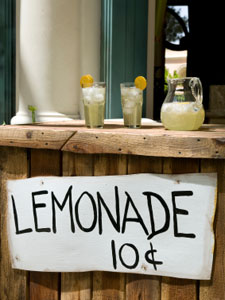Summer Tea Stand: Nostalgia & Great Teaching Tool!

Did you have a lemonade stand when you were a kid? If you have children, nieces or nephews, or work with kids, reviving the lemonade stand as a TEA STAND could be both a trip down nostalgia lane and a low-tech capitalism project!
A summertime tea stand is a great learning experience and a lot of fun, as both children and teens can learn business skills like how to create a product, sell it, and figure out what to do with the profits! This business model can be replicated many times in the future, and is great for those eight-years-old and older.
First, what to sell? Naturally, we think a balance between kid-friendly lemonades, herbal teas, and adult teas would be great, plus the iconic Arnold Palmer which uses lemonade with iced tea. If you have a good source for freezing, you can make popsicles out of herbal or true teas, a great take away item to sell. (For recipes)
For an easy-peasy way to make traditional iced black tea, gather the cleanest, biggest glass jar, put in six ounces of water for every tea bag, and set out on a sunny area of your home first thing in the morning. By noontime, when everyone wants something cool to drink, you'll be ready. Herbal teas can be made the same way, or boil per directions, allow to cool, then refrigerate until you are ready.
Second, you need to market! That's the way you can let everyone know what you're up to! Several days before your sale, place posters up in the neighborhood or at the community space. Draw up signs on colorful paper boards (let your inner artist go wild here). Make sure you cover all the basics: WHEN the sale is, WHERE it is, WHAT you are selling, HOW much it costs, WHO you are, and WHY you're doing this.
The WHY can be a strong selling point, especially if you're helping an organization, school, church or synagogue; or, supporting a sick friend, donating to your local library, or starting a fund for college education (parents or kids). Whatever the reason, if it's sincere and helpful, people will appreciate it and want to offer their support. If it's an organization you're supporting, ask for their brochures to help explain the work that they do.
Get change! Go to the bank or your at-home savings bank for change. If you charge $1 a cup, keep at least 10 singles on hand. If you charge fifty cents, make sure you have change for the customer; one $10 roll of quarters should do it. An old cardboard box, hidden under the table, can be your cash box. Keep a receipt book handy, too, in case anyone needs one. It's also a good way to keep track of sales. A little notebook is fine, too.
Pricing is always a challenge, and iced teas need to be priced so that they're affordable for your audience and easy for you to handle with change. Add up all the money spent to purchase teas, sugars, ice, lemons/limes, cups and napkins. Even if you already have these at home, you need to know the investment that was made. If you charge $1 a cup, how many cups will you have to sell to cover your costs? How many will you have to sell to make more than your expenses? Making more is called profit, and profit is what you can keep, less the money you got from the bank to make change. And, yes, if the market will pay more than $1, then charge more.
Here are some more things for the To Do List:
- Get some unbreakable pitchers to hold the beverages.
- Stock up on ice, paper cups, and small paper napkins, sugar cubes (honey and agave get sticky, so go with what's neat!). Slice some limes or lemons and keep them on a plate with a plastic fork to hand them to your customers who want them.
- Fill a cooler or tin bucket with the ice and keep it under the table. Add a set of tongs to get the ice cubes easily. You may also want to keep all but one pitcher in the cooler to keep the tea fresh.
- Get the table and a covering, either wrapping paper or a tablecloth. You might even want to place a few chairs around for either your customers or you! Place the cups, napkins, sugar cubes, lemons/limes, and the drink pitchers in a pretty way, and you're ready to sell!
- After the Tea Stand Sale hours, it's time to clean up. Recycle what you can (brewed tea is great for plants and compost!) and put the rest in the trash. Wash and put away the pitchers, utensils, and the cooler. Return anything you've borrowed (chairs, table, cloth) and, if you have leftover napkins and cups, keep them handy for the next Tea Stand Sale!
Now comes the best part. Count up your earnings, pay back the costs of supplies, then get a check or money order for the profits and send it to your charitable cause. And, if the money is for you, put it into your savings account. Congratulations! You've just created a small business! Will you do it again? If not, what will you do next?
